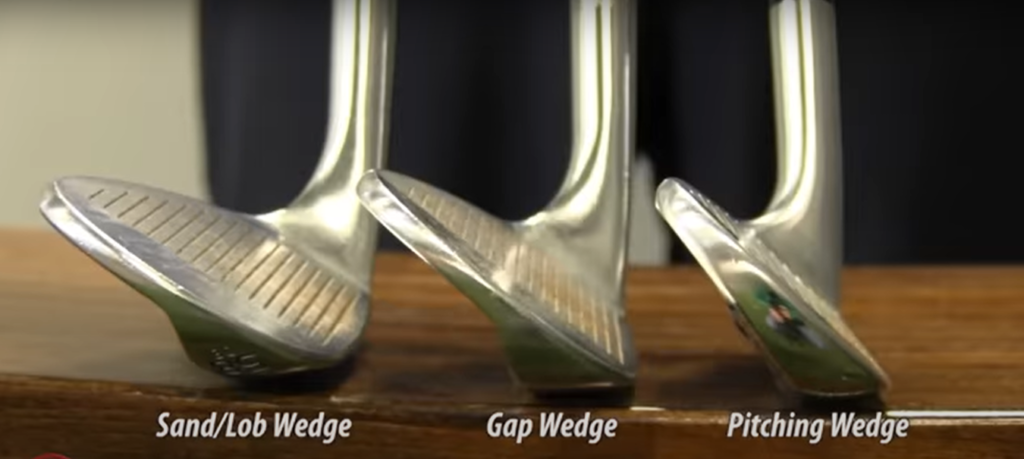Every golfer has had those moments where he’s just a few yards away from the hole, but his approach shot fails him. I’ve been there too. But let me tell you, there’s a game-changer you need to know about – the Wedges!
In this guide, we’ll exclusively talk about the approach wedge.
The approach wedge is not just another club; it’s the one that brings precision and control to your short game. From chips to bunker escapes, it helps you score better in every way.

If you’re a beginner, you probably have plenty of questions about it. What is an approach wedge? How’s it different from other clubs? And when and how should you use it? I’ve been through these doubts too, but when I finally embraced it, my short game reached new heights.
In this guide, I’m going to share all my approach-shot wisdom with you. So, say goodbye to missed shots and get ready to add another amazing club to your collection.
What is an Approach Wedge?
The approach wedge, also known as a gap wedge or an A wedge, fills the gap between your pitching wedge and sand wedge. The loft of the pitching wedge is about 43 to 44 degrees. While that of the sand wedge is 54 to 56 degrees. It leaves about 10 to 12 degrees of gap in between.
Now, the golfers needed something in between. That’s where the approach wedge steps in with a loft of 48 to 52 degrees. It is one of the most versatile clubs used in golf. It can be useful at par 3s to pitch shots.
The Purpose of an Approach Wedge
You cannot attain the practicality and effectiveness of an approach wedge with any other club. It serves as the ideal club when your shot is closer than your pitching wedge distance but farther than your sand wedge distance. It also offers a steeper angle than the pitching wedge, resulting in a lesser roll-out and a well-controlled shot.
So, when you find yourself facing that specific distance gap (of about 100 yards) on the course and need a club that offers both distance and control, the approach wedge is the go-to choice.
What Degree is an Approach Wedge?
An approach wedge typically has a loft between 48 and 52 degrees, but the exact loft may vary among different golf manufacturers. Many golfers prefer their wedges to have gaps of no more than six degrees in-between them, with some opting for even smaller gaps.
In the past, approach wedges used to have lofts ranging from 50 to 54 degrees, but nowadays, they usually fall within the 48 to 52-degree range, depending on the brand.
So, when you are choosing an approach wedge, consider the loft angle in relation to your other clubs, rather than solely relying on the number or name of the club. Understanding these loft complexities will help you make informed decisions and find the perfect approach wedge that complements your other clubs and elevates your performance.
When to Use an Approach Wedge?
An approach wedge has proven its usefulness in various golf scenarios, making it a vital club in your bag. From full-swing shots to pitch shots, chip shots, and bunker play, these wedges approach all challenges with equal efficacy.
Let’s take a look at each type of shot.
- When playing pitch shots and chips, the approach wedge’s loft provides a balance of lower trajectory and sufficient spin for controlled shots.
- While dealing with the longer bunker shots, you don’t need to exert excessive power; simply open the face a bit and hit the shot subtly, and the ball will land closer to the hole.
- If you have to take your ball out of the rough, an approach wedge will get it out and help it land softly on the green.
The Different Wedges You Might Confuse In
Now, in the golf game, we have different types of wedges – pitching wedge, lob wedge, sand wedge, and the approach wedge that we’ve been talking about. To exclude the chance of any confusion that might arise in your mind, let’s have a quick look at all of them.

First, we have the pitching wedge, which is the lowest lofted wedge, used for longer approach shots to the green. It provides a good balance of distance and control.
Next up, we have the gap wedge, also known as the approach wedge. It fills the yardage gap between your pitching wedge and sand wedge, making it ideal for shots closer than the pitching wedge distance but farther than the sand wedge distance.
Then comes the sand wedge. It comes to use when you find yourself in a bunker. With its loft typically around 54 to 56 degrees, it gets the ball out of the sand with ease.
Lastly, we have the lob wedge. It is the highest lofted one, ranging from 58 to 64 degrees. It is used when you need to pop the ball high and land it softly.
Related Reads:
The 2 Best Approach Wedges I Tried:
When buying an approach wedge, first check the lofts of your current pitching wedge and sand wedge. Note how far you hit each with a full swing. Find an approach wedge that fits between these lofts and covers the yardage gap you need.
After trying out various wedges along my journey, I’ve found two options that I’m confident about:
Titleist Vokey SM7 Approach Wedge:

It’s no wonder that some of the biggest names in golf have used this masterpiece in tournaments. The SM7 offers excellent bounce, toe, and heel, making it great for full swings and bunker shots alike. If you’re a pro looking for ultimate control, this wedge won’t disappoint. You can find it officially on the Tiliest website or on Amazon and Walmart.
Wilson Harmonized Approach Wedge:

This club helped me a lot when I was a mid-handicap golfer. It provides forgiveness and performance that elevates your game. Its blade shape offers maximum spin, even for less skilled golfers, and ensures a solid grip. It is also very budget-friendly. You can grab it on Amazon and Walmart.
To Sum It Up
To conclude, the approach wedge plays a crucial role in your short game, aiding in pitches, chips, and bunker shots. Selecting the right approach wedge can make a remarkable difference in your game. Remember to consider the loft of your pitching wedge and sand wedge while getting it.

If you’re confused about what to buy, the Titleist Vokey SM7 Approach Wedge stands out for its precision and versatility, favored by professionals on the tour. On the other hand, if you’re a mid to high handicap, the Wilson Harmonized Approach Wedge offers forgiveness and performance.
So, go ahead and find that perfect approach wedge that complements your playing style and takes your golf game to new heights. Happy golfing!
FAQs
Q) How do you hit an approach wedge?
A) To hit an approach wedge, set up with a slightly open stance and position the ball in the center of your stance. Take a controlled, smooth swing, focusing on maintaining a steady tempo. Aim to make clean contact with the ball, producing a controlled and accurate shot.
Q) How many wedges should I carry?
A) The number of wedges you should carry in your golf bag depends on your individual playing style. Most golfers carry at least two wedges, a pitching wedge, and a sand wedge. The pitching wedge is a standard part of most iron sets and is useful for longer approach shots to the green. The sand wedge is used for escaping bunkers with more loft.
As you progress, you may consider adding more wedges to your bag. A gap wedge or approach wedge can be beneficial to fill the gap between your pitching wedge and sand wedge.
Q) What is an approach wedge vs gap wedge?
A) An approach wedge and a gap wedge are two names for the same type of golf club. They both serve the purpose of filling the yardage gap between the pitching wedge and the sand wedge in a golfer’s bag. The terms “approach wedge” and “gap wedge” are used interchangeably to describe this club.
Q) Do I really need an approach wedge?
A) Whether you need an approach wedge depends on your playing style and the distance gaps you face. It can provide versatility and precision around the greens, but it’s not essential if you’re a newbie and your current wedge setup works well for you.
A guy with a charming face following his passion (both Golf and Blog) from Kansas. Bryan is the writer and creator of IAmLearningHowToGolf.com, loves golf, but he didn’t start playing until he was in his 20s. He’s not a pro by any means, but he’s put in the time and effort to get pretty darn good. Bryan’s main goal with this blog is to help other golfers improve their game and have more fun on the course. He does this by writing informative, relatable, and down-to-earth content. When he’s not golfing or writing, Bryan enjoys going on hikes, spending time with his family, and watching movies sometimes. For any queries reach out to him at Bryan@iamlearninghowtogolf.com.

